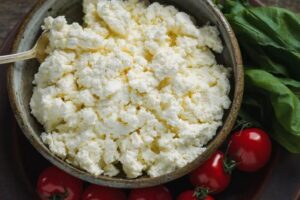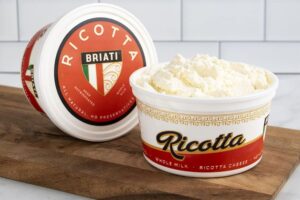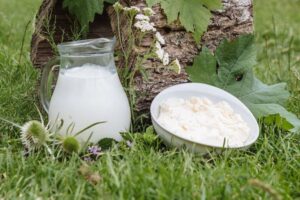Ricotta is frequently referred to as “cheese”. You might be surprised to learn that it isn’t really cheese. This is because ricotta is created from milk that has already undergone some processing.

Whereas cheese is made from milk that is in its original state. There are different types of ricotta cheese, two could be made from art skim and whole milk.
Because it is made out of cow milk and sometimes other types of milk, ricotta often contains fat. However, there are varieties without fat or less fat.
Let’s Compare Part Skim and Whole Milk Ricotta
What is the Part Skim Ricotta?
Part-skim ricotta is a variety of ricotta cheese made from skim milk or low-fat milk. It contains a lower fat content compared to whole milk ricotta, typically around 2-4%.
This version of ricotta cheese is lighter in texture and milder in flavor compared to whole milk ricotta. It’s often chosen by individuals looking to reduce their fat intake.
Even with their dietary restriction, they can still enjoy the taste and texture of ricotta cheese in various dishes.
What is the Whole Milk Ricotta
Whole milk ricotta is another type of ricotta cheese but made from whole milk. It is a creamy and slightly grainy cheese that originates from Italy.
It is produced by re-cooking the whey leftover from the production of other cheeses, such as mozzarella. To make whole milk ricotta, whole milk is heated and then acidified.
Usually, this is with the addition of vinegar, lemon juice, or citric acid. The acid causes the milk to curdle, separating the curds (solid) from the whey (liquid). The curds are then strained and there you have your ricotta cheese.
Fat Content and Calories
Whole milk ricotta is made from whole milk which contains a higher fat content, usually around 6-8%. The whole milk kind is rather heavy in saturated fats and cholesterol.
Part-skim ricotta, on the other hand, is made from skim milk or low-fat milk. Thus, it contains a lower fat content, typically around 2-4%.
Whole milk ricotta cheese typically has 428 calories and 32 grams of fat per 1-cup serving. Although it is not considerably less, part-skim ricotta has less fat and calories per serving.
One cup contains 242 calories and 19.6 grams of fat. Alternatively, fat-free ricotta has no fat and it contains about 160 calories. If you would like to reduce your intake of ricotta cheese, you can purchase a lower-fat kind.
Texture
We’ve noted the variance in fat content of both part skim and whole milk. The difference in texture mostly stems from the difference in fat content.
For this reason, whole milk ricotta tends to be creamier, richer, and softer in texture. Part-skim ricotta is lighter and may have a slightly grainier texture compared to its whole-milk version.
The texture also depends on whether the ricotta is store-bought or homemade.
Nutritional Value and Minerals

Whether whole milk or part-skim, ricotta cheese contains several vitamins, nevertheless in varying amounts. The kind of milk used in making the ricotta can also affect its nutritional value and calories.
Part-skim ricotta is a high source of protein, compared to whole milk. This of course is essential for various bodily functions, muscle repair, and overall health.
Being a dairy product, Ricotta is a good source of calcium. We know this can aid in maintaining strong bones and teeth, as well as supporting nerve function and muscle contraction.
Whole milk ricotta may have slightly more calcium compared to part-skim ricotta because it retains more of the milk’s natural components. Ricotta is also rich in sodium.
Part-skim ricotta would generally contain a slightly higher level of sodium compared to whole milk ricotta.
Ricotta contains vitamin A, Vitamin D, and Vitamin K2. It also contains various B vitamins in small amounts such as riboflavin (B2), vitamin B12, and pantothenic acid (B5).
The exact amount can vary among brands. Therefore, it’s important to check the nutrition labels of the brand if you’re concerned about sodium intake.
The Difference in Flavor
With less fat, part-skim ricotta might have a slightly less rich taste compared to whole-milk ricotta. Because of the higher fat content in whole milk ricotta, it has a richer flavor profile.
Contrarily part-skim ricotta might have a milder taste due to the reduced fat content. Typically, whole milk is the ideal milk for making ricotta.
Although many people have successfully used the part-skim, sometimes, there isn’t enough milk fat in skim or nonfat milk. This could affect how the milk splits into curds and whey.
Recipes to Use Each Ricotta For
Part-skim is a good option for those looking to reduce their fat intake. Despite this, they can still enjoy ricotta in various recipes like lasagna, stuffed shells, or desserts.
Whole milk ricotta is often preferred in recipes where a richer taste and creamier consistency are desired. They can be used in cannoli filling, cheesecakes, or for spreading on bread or crackers.
Whole milk ricotta tends to be richer and creamier compared to ricotta made from skim milk.
It’s used in various Italian dishes like lasagna, stuffed pasta, and cannoli filling, and also works well in desserts, spreads, or as a topping for dishes due to its mild and versatile flavor.

For instance, both of these types of ricotta can be used in lasagna. It completely depends on your individual preferences. Some might prefer the richness of whole milk ricotta.
Whole milk ricotta is often preferred by many chefs and home cooks for lasagna because it has a richer flavor and creamier texture. This would make it a more satisfying dish.
Otherwise, others might opt for the lower-fat content of part-skim ricotta. If you have dietary restrictions, then the part-skim ricotta might be a better choice.
They are sort of a reduced-fat dairy which still works well in lasagna and other recipes. Although it might have a slightly different texture.
Whichever one you opt for between them comes down to personal preference and dietary considerations.
Can you Substitute Part Skim for Whole Milk Ricotta?
In most recipes, you can substitute part-skim ricotta for whole milk ricotta. Because Part-skim ricotta has a lower fat content compared to whole milk ricotta, it might slightly affect the taste or quality of the dish.
However, in most recipes, the substitution should work fine without drastically altering the outcome.
If you’re using part-skim ricotta in a recipe that calls for whole milk ricotta, you might notice a slightly drier texture. This means that your ricotta might not be as creamy as the whole milk version.
You could make up for it by adding a small amount of cream or a bit of melted butter. Additionally, adjusting other ingredients like adding a bit more liquid ingredients would suffice, such as adding milk or beaten egg.
In recipes like lasagna, stuffed shells, or cheesecakes, ricotta is a common ingredient. In these recipes, the difference between part-skim and whole milk ricotta may not be very noticeable.
Especially once you mix it with other ingredients. To be safe, always consider the specific recipe when making substitutions.
Finally
Whole milk, and skim milk ricotta all have distinct nutritional contents. Part-skim may be a better choice for those limiting their calorie intake.
The health benefits of each one will vary depending on the demands and dietary needs of the individual.
